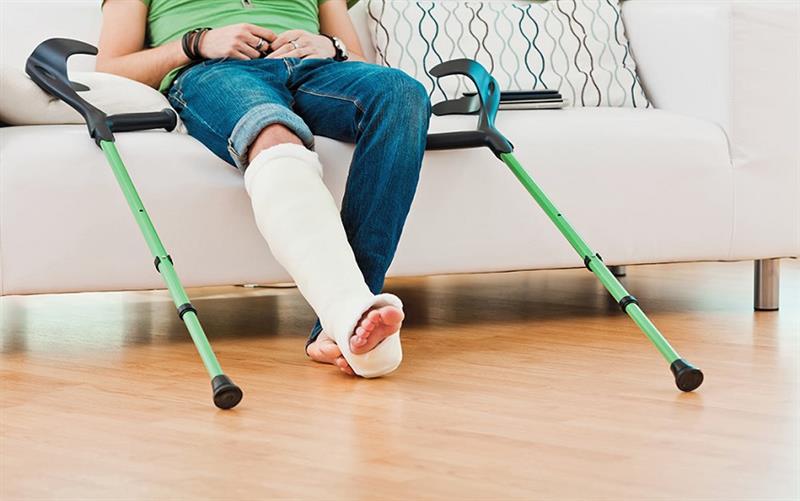
The most crucial aspect of using crutches is moving carefully and safely to prevent damaging the location of your surgery or reinjuring your leg. Before you use crutches at home, your healthcare practitioner can demonstrate how to stand, move, walk, and use stairs.
Who requires crutches?
One of the most popular medical equipment that people use when healing from an injury or following surgery are crutches. They are what is referred to as a mobility aid—a device that facilitates movement.
With the aid of crutches, you can stand, walk, and move around without placing all of your weight on your injured leg, knee, or ankle.
Your doctor or orthopedist will be able to advise you on the best type of crutches to use, how long you should keep using them, and how to do so safely.
How soon will I require crutches?
After an injury or surgery, crutches are frequently required. Among the most typical are:
- Sports injuries: You may need to use crutches while recovering from a variety of injuries, including sprains, ACL tears, and torn meniscus.
- Bone fractures: If you break a bone in your leg, knee, ankle, or foot, you might need crutches.
If you suffer from a ligament or tendon injury, such as an Achilles tendon rupture or tendinitis, your doctor may advise you to use crutches.
- Surgery: After lower body surgery, such as typical treatments like arthroscopic surgery, you could need crutches.
Can I carry a certain amount of weight with crutches?
The reason you require crutches and how far along you are in your recovery will determine how much weight or pressure you can place on your leg, knee, ankle, or foot. How much weight you can carry on your healing side will be determined by your doctor, surgeon, or physical therapist; this is known in medicine as "weight bearing." They might make use of words like:
Non-weight bearing: The area of your body that is healing cannot support any weight.
Toe contact only for balance: Just your toe should touch the ground to help you balance yourself again. Never put pressure or weight on it.
Your doctor will advise you to utilize a set proportion of your weight, such as 50% or 80%, or to partially display your weight. This is more of a guide to assist you understand how much you can use your recuperating leg; it's not typically a number that you can't exceed. Imagine supporting that much of your normal weight while you stand, walk, and move about.
Weight Bearing : Bearing weight as tolerated This indicates that you are able to use your entire weight as frequently as possible without experiencing any discomfort. A healthcare professional must first give you the okay before you push past your limitations.
What kinds of crutches are there?
You could require one of the following types of crutches:
The most popular sort of crutches are underarm (axillary) crutches. They have a handgrip, a straight frame, and a padded top that goes under your arm below your armpit.
- Crutches for the forearms:
You may hear people refer to these as elbow crutches. Typically, they are not as long as underarm crutches. Crutches for the forearm contain a handgrip and a supporting cuff that goes around the back of your upper arm just above your elbow.
Compared to the other forms, gutter crutches are less typical. They have a straight pole with a padded pocket on top of it. Your forearms rest in the pocket as you grasp the handgrip at the bottom.
How can I make using crutches more cozy?
Your crutches will be more comfortable if you adjust them:
Most crutches have a sliding mechanism that allows for adjustment. Before using them, seek assistance from your doctor or a physical therapist in customizing the length to your body.
Be sure to adjust your crutches to fit your height. If you are using underarm crutches, the handgrips should be around your hips and the top should end a few inches below your armpits. Use the handgrips to support your weight at all times. Avoid leaning on the top of your crutches when you are walking.
Safety advice for using crutches:
- Verify that your crutches have rubber tips with grooves covering the bottom, as well as soft cushioning on the underarm support and handgrips.
- After using your crutches outside, check the bottom of each one for any material that can cause you to slip, such as stones, leaves, or anything else.
- Make sure there isn't any clutter in your house or office that could trip you or others.
- As long as your doctor instructs you to, use crutches. You risk reinjuring your leg or damaging the surgical site if you stop using them too soon, even if you feel like you're recuperating quickly.
How do I use crutches to walk?
It's crucial to walk cautiously when using crutches as you heal. After surgery, you might need to get up and move as soon as the next day. When you should begin walking, your surgeon will instruct you.
The same procedures apply if your foot or ankle is in a boot or cast; however, you should only put as much weight on your foot as your doctor has instructed.
- Before moving, make sure you are safely balanced.
- Crutches and your recuperating leg should be moved forward simultaneously.
- Step through with your other leg while applying equal and even pressure to both handgrips.
- Prior to taking another stride, regain your balance.